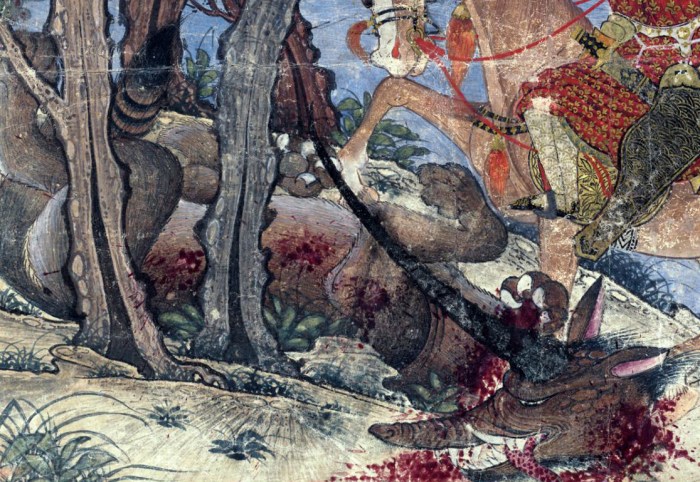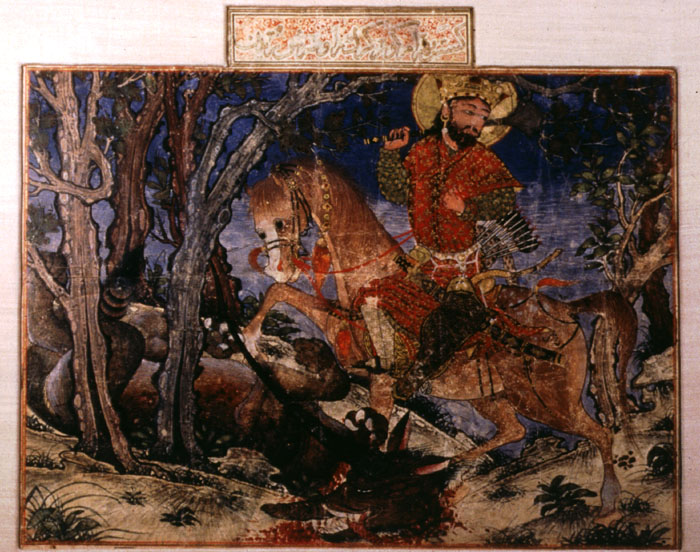Bahram gur fights the karg – In the annals of ancient Persia, the tale of Bahram Gur’s valiant encounter with the formidable karg unfolds as a captivating saga of courage, cunning, and the triumph of good over evil.
This timeless legend has captivated generations, weaving a tapestry of adventure, symbolism, and cultural significance that continues to resonate today.
The Story of Bahram Gur and the Karg

The story of Bahram Gur and the Karg is a Persian epic that tells the tale of a young prince who sets out on a quest to kill a mythical creature known as the Karg. The Karg is a monstrous beast that has been terrorizing the countryside, and Bahram Gur is determined to rid the world of its evil.
The significance of the Karg in the story is that it represents the forces of chaos and destruction. The Karg is a powerful and dangerous creature, and it is a symbol of the dangers that can befall those who are not careful.
Bahram Gur’s quest to kill the Karg is a metaphor for the struggle between good and evil, and his victory over the beast represents the triumph of hope over despair.
Bahram Gur’s Quest
Bahram Gur’s quest to kill the Karg is a long and arduous one. He must travel through treacherous mountains and forests, and he must face many dangers along the way. But Bahram Gur is a brave and determined prince, and he is not afraid to face the challenges that lie ahead.
Along the way, Bahram Gur meets a wise old man who gives him advice on how to defeat the Karg. The old man tells Bahram Gur that he must use his intelligence and cunning to overcome the beast’s strength and power.
Bahram Gur follows the old man’s advice, and he is eventually able to defeat the Karg. He uses his intelligence to outwit the beast, and he uses his cunning to trap it. Bahram Gur’s victory over the Karg is a great triumph, and it brings peace and safety to the countryside.
Bahram Gur’s Character

Bahram Gur, the protagonist of the story, is a complex and multifaceted character. He is a brave and skilled warrior, a wise and just ruler, and a passionate lover. However, he is also flawed, with a tendency towards arrogance and recklessness.
Bahram Gur’s character traits influence his actions in the story in many ways. His bravery and skill in battle allow him to defeat the Karg and save his kingdom. His wisdom and justice make him a respected and beloved ruler.
And his passion for love leads him to pursue the beautiful princess, Azada.
Motivations
Bahram Gur’s motivations are complex and varied. He is driven by a desire for glory, a sense of duty, and a longing for love. He wants to be the greatest warrior in the world, to rule his kingdom wisely and justly, and to find a woman who will love him unconditionally.
Bahram Gur’s motivations often conflict with each other. For example, his desire for glory leads him to take unnecessary risks in battle, while his sense of duty compels him to put the needs of his kingdom before his own. Ultimately, Bahram Gur must learn to balance his different motivations in order to achieve his goals.
The Fight Between Bahram Gur and the Karg

Bahram Gur, the legendary Sassanid king, faced a formidable challenge when he encountered the monstrous karg, a creature of darkness. This epic confrontation tested Bahram’s courage, strength, and determination.
Events Leading Up to the Fight
Bahram Gur’s reputation as a skilled hunter reached far and wide. Hearing tales of the karg terrorizing the land, he resolved to confront the beast. Guided by his loyal companions, Bahram ventured into the desolate mountains where the karg dwelled.
Bahram Gur’s valiant battle against the Karg is a testament to his unwavering courage. If you’re curious about the intricacies of electrical circuits, the ohm’s law lab answer key provides invaluable insights. Returning to Bahram Gur’s heroic feat, his triumph over the monstrous Karg serves as a reminder of the indomitable spirit that resides within us.
The Fight
As Bahram and his party approached the karg’s lair, the ground shook beneath their feet. The monstrous creature emerged from the shadows, its eyes blazing with malevolence. A fierce battle ensued, with Bahram’s arrows proving ineffective against the karg’s thick hide.
Undeterred, Bahram closed in on the karg, wielding his sword. The beast fought back with its sharp claws and powerful jaws. Blood and gore flew as the two adversaries exchanged blows.
The Outcome
In a moment of desperation, Bahram aimed a swift blow at the karg’s heart. The blade pierced through the creature’s hide, sending a surge of dark energy coursing through Bahram’s body. With a deafening roar, the karg collapsed, its evil presence vanquished.
Bahram’s victory over the karg became a legend, solidifying his reputation as a valiant hero. The land rejoiced, freed from the terror that had haunted it for so long.
Symbolism in the Story: Bahram Gur Fights The Karg

The story of Bahram Gur and the Karg is replete with symbolism, each element carrying deeper meanings that enhance the narrative and convey profound truths.
One prominent symbol is the Karg itself. This mythical creature represents the challenges and obstacles that Bahram Gur must overcome on his journey to self-discovery and enlightenment. The Karg’s impenetrable hide symbolizes the difficulties and adversity that he faces, while its fierce nature reflects the inner struggles and temptations he must confront.
The Lion
The lion, which Bahram Gur slays to obtain the Karg’s hide, symbolizes courage, strength, and determination. Bahram Gur’s victory over the lion represents his triumph over his own fears and limitations, and his emergence as a true hero.
The Throne
The throne on which Bahram Gur sits at the end of the story represents his ultimate triumph and the fulfillment of his destiny. The throne symbolizes power, authority, and the responsibility that comes with leadership.
The Cypress Tree, Bahram gur fights the karg
The cypress tree, which Bahram Gur plants at the grave of the Karg, symbolizes hope, renewal, and the enduring legacy of his victory. The tree’s evergreen nature represents the enduring nature of Bahram Gur’s achievements and the lasting impact he has on his kingdom.
Cultural Context

The story of Bahram Gur and the Karg was written during the Sassanid period in Persia, which lasted from 224 to 651 CE. This period was a time of great cultural and artistic achievement, and the story reflects the values and beliefs of the Sassanid era.
The story of Bahram Gur and the Karg is a heroic tale that celebrates the virtues of courage, strength, and loyalty. These were highly valued traits in Sassanid society, and the story served to inspire and motivate the people of the time.
Relevance to the Culture
The story of Bahram Gur and the Karg is also relevant to the culture of its time because it reflects the Zoroastrian beliefs of the Sassanid era. Zoroastrianism is an ancient religion that emphasizes the importance of good thoughts, words, and deeds.
The story of Bahram Gur and the Karg teaches the importance of these virtues and shows how they can lead to success and happiness.
Top FAQs
Who is Bahram Gur?
Bahram Gur was a legendary Persian king renowned for his bravery, hunting prowess, and love of adventure.
What is the significance of the karg?
The karg, a monstrous creature, symbolizes the challenges and obstacles that Bahram Gur must overcome in his quest for glory.
How does Bahram Gur’s character influence the story?
Bahram Gur’s unwavering courage, cunning, and determination drive the narrative, shaping the events and outcomes of the story.
What cultural context influenced the story?
The story reflects the cultural values and beliefs of ancient Persia, including the importance of heroism, honor, and the struggle against evil.